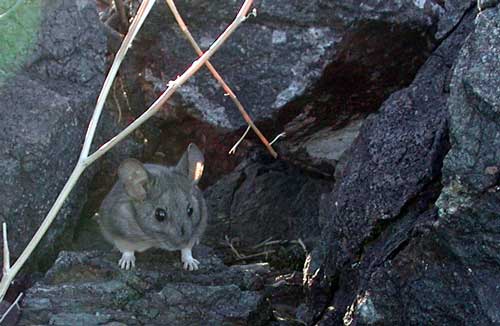Whitethroat Woodrat
Neotoma albigula

Photographed at summit of North Mountain, Phoenix, where apparently this individual had learned to find food dropped or offered by hikers.
Sponsored Links:
There are several difficult to distinguish woodrats - a.k.a. packrats, in the deserts of Southwestern United States. The whitethroat woodrat is fairly easy to identify: the hairs of throat are white to base. The feet are also white. Unlike common house rats their tails are not scaly, instead the tails are furred. Also, their ears are larger.
These largely nocturnal mammals feed on palo verde, ironwood, and mesquite beans; also on cactus, fruits and other seeds. They nest beneath dense cacti, within caves or deep recesses in cliff faces. They very often form huge mounds of gathered cactus joints and twigs to make a seemingly impenetrable fortress against foxes, coyotes and snakes.
Probably the most amazing thing about these rodents is the fabulous record of history that their nesting and hoarding behaviors have created. They often nest within deep caves along washes and cliffs, protected from wind and rain, where year after year they gather and store every sort of vegetable matter they find: pine cones, juniper berries, seeds, twigs, cactus, even animal bones. Upon this collection they live, nest, bare their young and most importantly urinate - a urine that is concentrated and preservative. Eventually layers form that are thousands of years old (up to 40,000 BCE!) thus recording the changes in vegetation and hence climate and ecology.
Muridae -- Mouse, Vole & Rat Family
More Information:
- Smithsonian North American Mammals
- Univ. of Michigan Animal Diversity Web
- ITIS Taxonomic Report
- Google Images
- Google Scholar Literature Search
- Reference: Mammals of Arizona (1986), D. F. Hoffmeister, Univ. of Arizona Press.
- Reference: Packrat Middens (1990), J. L.Betancourt, T. R. Van Devender and P. S. Martin. Univ. of Arizona Press.
- Reference: A Field Gude to the Mammals, 3rd Edition (1976), W. H. Burt, Houghton Mifflin Company.